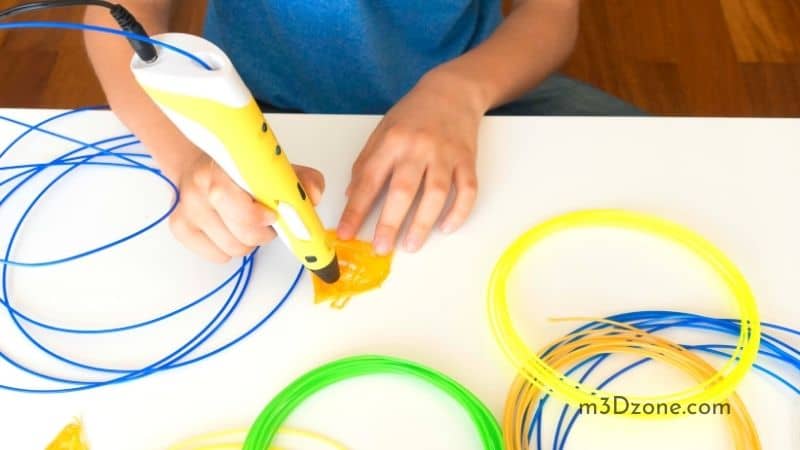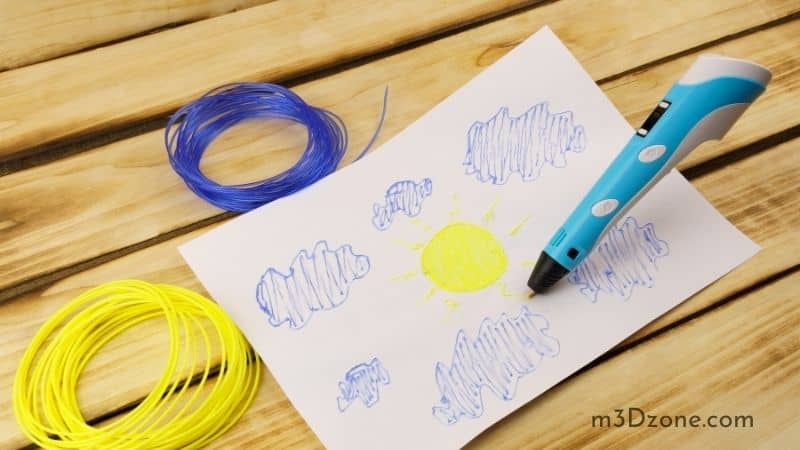3D pens can be quite sensitive and are prone to break especially when they overheat. The surfaces you use your 3D pen are very important. Stick around to find out more about this.

Using a 3D pen can be intimidating for a beginner. But being a creative person, you love something that triggers and enhances your imagination.
We have made it quite fast and easy for you to get the information you need on the surfaces you can use a 3D pen on.
What Do You Use a 3D Pen On?
The 3D printing pen is a state of the art technology. You may be used to 3D printers, but this is a new phenomenon. Most 3D pen templates confirm that it works by heating a plastic filament to its melting point.
Thus, forcing it through an extruder tip. The melted filament is soft and is fused on a build surface. This encourages you to be creative and imaginative when working on the shapes you like.
What Surfaces Can You Use a 3D Pen On?
Cardboard is one of the surfaces that is highly recommended for use by beginners. In fact, comments from 3D pen users certify this. This is because the cardboard is firm, so retrieving the pattern drawn is easier.
Decorative designs can also be raised on a plain and clean ordinary paper sheet. You are allowed to design the pattern depending on the size of the paper outlay.
You can also maximize the use of printed drawing papers or the idea of drawings from stencils. Wax paper is another excellent material for using a 3D pen. This is because it allows the hot filament to cool on it so that the process of retrieving the pattern after the heat cools is easy.
You can design the shape of an object on the surface of a piece of glass. The temperature settings on the 3D pen vary depending on the surface the drawing is made on. The pens have to be adjusted accordingly.
The 3D pen can also be used to modify or even repair other 3D printed objects or things. This kind of application is most common with repair technicians. You may not need to use glue, and the results will be perfect.
Can You Use a 3D Pen on Paper?
Yes, you can!
Are you keen on creating a complex 3D structure? Here are some tips! You can draw the faces of the intended object on a piece of a paper sheet. Alternatively, you can download different 3D pen stencils or create personal templates.
Just draw lines by holding the tip of the pen as you do with the ordinary pen.

Using a paper page is all you may need to do under normal circumstances. As much as you can draw 3D objects on several surfaces, the paper page gives you the chance to use your imagination.
Top on this aspect is that you can hand-draw objects or use stencils before using your 3D pen.
One thing that makes the paper a top priority is removing the filament after the temperature has gone down is easy. Especially at the edges, You may use wax; this results in safe retrieval of the designed objects.
The paper also provides an option of working on an array of pictures. You can engage your 3D pen in the ordinary course of your work on a picture and come out with a similar pattern.
This can be fascinating to kids who will delight in this technology.
What Is the Best Surface for the 3D Print On?
No doubt, the key to a successful 3D print is the first layer. Having said so, there are many good surfaces for the 3D print. However, the following stand out.
-
Glass
The glass build surface is one of the most popular surfaces for 3D print. This is because it is straightforward to use. Glass is overly stiff, and its perfectly flat surface enables the printing to be done in precision.
It doesn’t warp with time, providing the much-needed quality assurance.
It provides a flatter and solid space to carry out the 3D printing process. Still, the glass surface does not heat quickly, making it safe to use.
You are always advised to use adhesives to get the best results with the first layer printing surface.
However, the glass is fragile, and you should handle it with care to avoid damages.
-
Anycubic Ultrabase
This is an excellent surface for the 3D print process. It is a glass bed that contains structures of nanoparticles spread over the glass surface.
The nanoparticles have a critical function as they are attached to the print when hot and leave it loose when cooled.
This means you don’t have to remove the print manually from the surface when the process is complete.
Ultrabase is attached to the glass surface and also has the properties of glass. This means it is stiff, conductive, and flat as well. With it, there is absolutely no need to add adhesives to the glass surface.
Ultrabase has an inbuild adhesive surface that wears out with frequent use and needs replacement.
-
Aluminum
Aluminum is highly used in 3D printing, perhaps ranking next to the glass. The metal, being a good conductor of heat, enables heat to spread evenly through the build surface.
It also provides the unique advantage of coping with the rough methods used in removing the print. Still, it is used for longer periods without the need for replacements.
However, it has a fair number of challenges, as sticking the first layer on a surface that is not flat is difficult. Also, aluminum is a metal, and it can expand at high temperatures.
How to Work a 3D Pen Like a Pro
First, you need to select an excellent 3D pen with some of these features: good emanation time, good cooling time, a better clogging system, and ensure it operates under a range of temperatures.
Second, set the pen well. Make sure you set the plastic filaments well. Please switch it on to ensure it heats up in good time and choose the right temperature so that the plastic melt is consistent.
Ensure you press the button for the plastic to be dispensed with. Don’t forget to adjust the speed so that it releases the filament at the right speed.
Third, when all is set, you now need to start creating your desired object. Choose a clean, smooth, and flat surface. Place your design on top of the surface and make sure it doesn’t stick on the surface.
You then need to create a focal point. This is important as you will start dragging and drawing your sketch from this point.
Drag your pen while holding it closer to the surface. Also, please note that the hotter the plastic, the better it will adhere to the surface.
You need to continue with the drawing process until you are satisfied with the shape. Let the filament cool down, and then peel it off the paper gently.
You often end up with a product with rough edges that you will need to soften to give the product a better finish. Just heat the rugged edges to reset the plastic.
Conclusion
The 3D pen technology is here, and you need to make the most out of it. All you need is information on this pen: how to use it, the best surface you can use it on, etc. This will guarantee you enjoy the benefits that come with it.
Recommended Reading
Are 3D Pens Worth It?
Are 3D pens worth it? 3D pens are worth it only if you do sufficient research according to your needs. Get to know some of the best brands with the HQ quality.
How Long Does It Take to Charge a 3D Pen?
A 3D pen requires two hours of connection to a power supply to be fully charged. Connect it to a power supply using the USB cable it comes with after using it.
How to Clean a 3D Pen? 3 Easy Steps To Unclog It
Don't know yet how to clean a 3D pen? In this article, I will show you how easy is to clean your 3D pen nozzle and unclog it in just a few easy steps.
